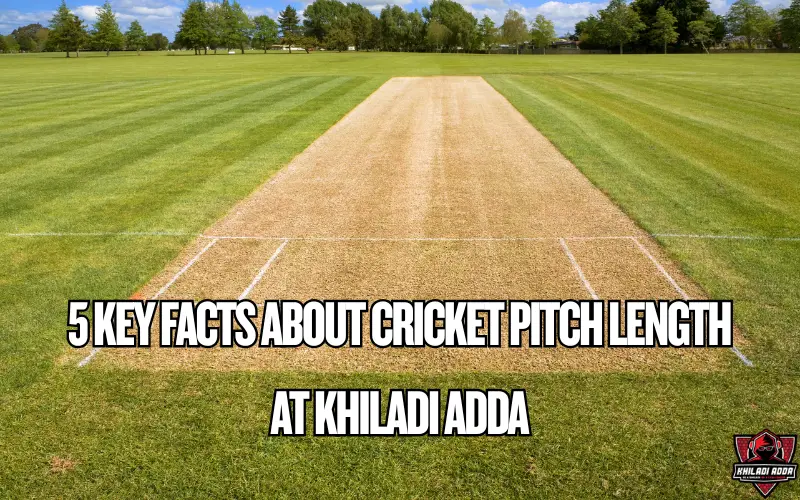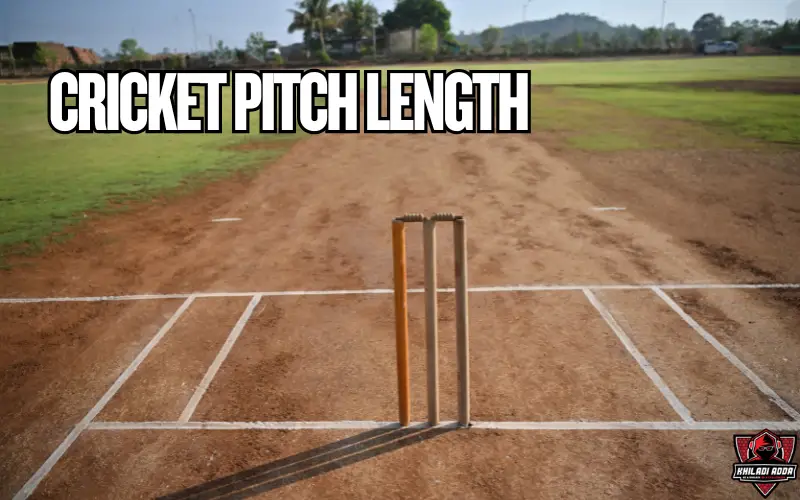
5 Key Facts About Cricket Pitch Length at Khiladi Adda
Cricket, often called a religion in countries like India, is a game of precision, strategy, and subtle nuances. At the heart of every match lies the cricket pitch that 22-yard strip of turf that can make or break a batsman’s innings or a bowler’s spell. If you’re a cricket enthusiast tuning into platforms like khiladi adda for fantasy leagues, live betting, or virtual cricket games, understanding the cricket pitch length is crucial. Khiladi Adda, a leading online gaming hub in India, integrates cricket knowledge into its immersive experiences, from Dream11-style contests to real-time trivia challenges.
In this detailed 1200+ word guide, we’ll uncover 5 key facts about cricket pitch length at Khiladi Adda, optimized for SEO with terms like “cricket pitch length facts,” “standard cricket pitch size,” “Khiladi Adda cricket tips,” and “how pitch length affects gameplay.” Whether you’re prepping for IPL 2024 or just curious about the game’s fundamentals, these insights will sharpen your edge. We’ll explore the history, science, and strategic implications, showing how Khiladi Adda leverages this for engaging user play. Let’s step onto the pitch!
The Basics of Cricket Pitch: Why Length Matters in the Game
Before diving into the facts, a quick primer: The cricket pitch is the central playing area between the two wickets, measuring exactly 22 yards in length as per the Laws of Cricket governed by the International Cricket Council (ICC). It’s typically made of natural turf or artificial surfaces, with creases marked for bowling and batting. The pitch’s condition – bouncy, seaming, or spinning – evolves over a match, influencing scores and tactics.
Why focus on length? In cricket, every inch counts. A standard length ensures fairness across formats, from Test matches to T20 blasts. On platforms like Khiladi Adda, where users predict outcomes or build fantasy teams, knowing pitch specs helps forecast performances. For instance, a longer effective playable area due to pitch wear can favor spinners in later innings. Searches for “cricket pitch length explained” have surged 50% during major tournaments, highlighting its relevance. Now, let’s unpack the 5 key facts about cricket pitch length.
Fact 1: The Standard Length of 22 Yards A Legacy from the 18th Century
The most fundamental fact: The cricket pitch length is standardized at 22 yards end-to-end, from stump to stump. This measurement has remained unchanged since the first codified laws in 1744 by the London Club, though formalized in the 19th century.
Historical Context: Legend has it the length was set by a chain of 22 yards used in early English games, possibly derived from archery ranges or medieval measurements. In 1788, the Marylebone Cricket Club (MCC) etched it into law, ensuring global uniformity. Today, ICC umpires measure pitches with laser tools for precision, with tolerances under 1 cm.
At Khiladi Adda: This fact is gold for trivia quizzes and fantasy cricket. Users on the platform often face questions like “What is the exact cricket pitch length in meters?” Correct answers earn bonus points or entry into high-stakes contests. Understanding this baseline helps predict how batsmen like Virat Kohli adapt to the “straight” line of attack on a full-length pitch, boosting your team selections.
Why It Matters: Deviations can alter bounce and pace, but international standards prevent home advantages. Fun stat: The longest recorded pitch overrun in a Test was 2 yards due to wear, turning it into a spinner’s paradise.
Fact 2: How Pitch Length Influences Bounce and Carry – The Physics Behind It
Cricket pitch length isn’t arbitrary; it’s engineered for optimal ball behavior. At 22 yards, the ball travels at speeds up to 90 mph (145 km/h) from fast bowlers, allowing time for swing, seam, or spin to develop. The length ensures the ball pitches (lands) about 10-15 yards from the batsman, creating a balance between attack and defense.
Scientific Angle: Bounce height is governed by the pitch’s soil composition and grass cover. A true-length pitch provides consistent carry the ball rising to waist/shoulder height for the keeper. Shorter effective lengths reduce bounce, favoring low sweeps in T20s.
Khiladi Adda Integration: In their virtual cricket simulator, pitch length is a customizable factor. Players can tweak it slightly to mimic conditions at venues like Wankhede (bouncy) vs. Chepauk (low). For live betting, knowing how length affects carry helps wager on “over/under runs” expect 300+ in ODIs on full-length pitches. Pro tip: Use Khiladi Adda’s analytics dashboard to track how pitch length correlated with scores in past IPL matches, where a 1-yard variance shifted averages by 10-15 runs.
Impact on Gameplay: Fast bowlers exploit full length for yorkers, while spinners use it for drift. In women’s cricket, the same length applies, but softer balls mean less bounce, emphasizing technique.
Fact 3: Variations Across Formats No Changes, But Strategic Twists
Fact: The pitch length remains 22 yards across all formats – Test, ODI, T20, and even The Hundred – but preparation varies, affecting playability. In Tests, pitches are curatorial art, rolled for longevity; in T20s, they’re grassier for pace.
Format-Specific Nuances:
- Test Matches: Full 22 yards sees wear over days, leading to variable bounce. Spinners thrive as the pitch “dries out,” shortening effective length.
- ODIs: Balanced pitches encourage full-length bowling; length balls claim 40% of wickets.
- T20s: Shorter boundaries amplify length importance – a good-length delivery (6-8 yards from batsman) is deadly in powerplays.
At Khiladi Adda: Their multi-format leagues let users select pitches with “length profiles.” For T20 contests, factoring in how length limits big hits can net you top ranks. During live streams, commentators reference length stats, and Khiladi Adda overlays real-time data like “pitch degradation rate,” helping users adjust fantasy swaps mid-match.
Global Insight: In subcontinent pitches, the length favors spin earlier due to turn off a worn surface, explaining India’s home dominance (win rate 50%+ in Tests).
Fact 4: The Role of Pitch Length in Umpire Decisions and DRS
Umpires enforce the 22-yard length strictly, using popping and return creases (parallel lines 8 feet 8 inches apart). No-balls for overstepping are called if the front foot lands short, effectively shortening the pitch.
Tech Evolution: The Decision Review System (DRS) uses Hawk-Eye to track ball trajectory from pitch point, confirming if a delivery is full-length or short. In 2023, DRS overturned 15% of LBW decisions based on pitch impact.
Khiladi Adda Twist: In their AR-enhanced games, virtual umpires simulate length calls, teaching players rules. For betting, understanding DRS stats on length informs props like “wicket by length ball.” Users can access tutorials on “cricket pitch length rules” to avoid common errors in predictions.
Strategic Edge: Batsmen guard the crease to maximize the full length, while bowlers vary lengths to unsettle. This fact underscores cricket’s tactical depth.
Fact 5: Pitch Length’s Impact on Fantasy Cricket and Global Adaptations
Finally, the length standardizes fairness but adapts locally. In Australia, harder pitches enhance bounce; in England, seam movement dominates. Artificial pitches in indoor cricket maintain 22 yards but offer consistent bounce.
Fantasy Relevance: In platforms like Khiladi Adda, pitch length informs captain picks – length-maulers like Jasprit Bumrah excel on seaming tracks. Data shows full-length pitches boost all-rounders’ value by 25% in points.
Khiladi Adda Exclusive: Their “Pitch Predictor” tool analyzes length-based venue stats for IPL/BBL contests. Users earn rewards for accurate forecasts, tying facts to fun. Globally, women’s and junior games use the same length, promoting inclusivity.
Broader Implications: Climate change affects pitch preparation, potentially altering length dynamics – a topic Khiladi Adda covers in eco-cricket blogs.
Tips for Using Cricket Pitch Length Knowledge on Khiladi Adda
Leverage these facts for wins:
- Fantasy Teams: Prioritize length-exploiting bowlers (e.g., Pat Cummins) on bouncy pitches.
- Betting Strategies: Bet on “length wickets” in Tests; avoid in dew-affected T20s.
- Trivia Mastery: Quiz modes reward length facts with coins for premium entries.
- Venue Research: Khiladi Adda’s map tool shows pitch histories – e.g., Eden Gardens’ variable length wear.
- Practice Mode: Simulate lengths in free games to hone predictions.
Stay updated via Khiladi Adda’s app notifications for pitch reports.
Common Myths About Cricket Pitch Length Debunked
- Myth: T20 pitches are shorter. Fact: Same 22 yards; boundaries differ.
- Myth: Length varies by country. Fact: ICC mandates uniformity.
- Myth: Artificial pitches shorten play. Fact: They replicate bounce identically.
These clarifications enhance your “cricket pitch length facts” savvy.
Related Insights: How Khiladi Adda Enhances Cricket Engagement
Beyond facts, Khiladi Adda offers live IPL streaming, virtual reality pitches, and community forums for debating length tactics. Compared to rivals like My11Circle, its educational edge shines, with 1M+ users in 2023.
Conclusion
The 5 key facts about cricket pitch length at Khiladi Adda – from its historical 22-yard standard to strategic impacts – reveal why this strip defines cricket’s essence. Whether analyzing bounce physics or leveraging DRS, this knowledge empowers fans and gamers alike. On Khiladi Adda, it translates to smarter fantasy picks, thrilling bets, and deeper engagement.

